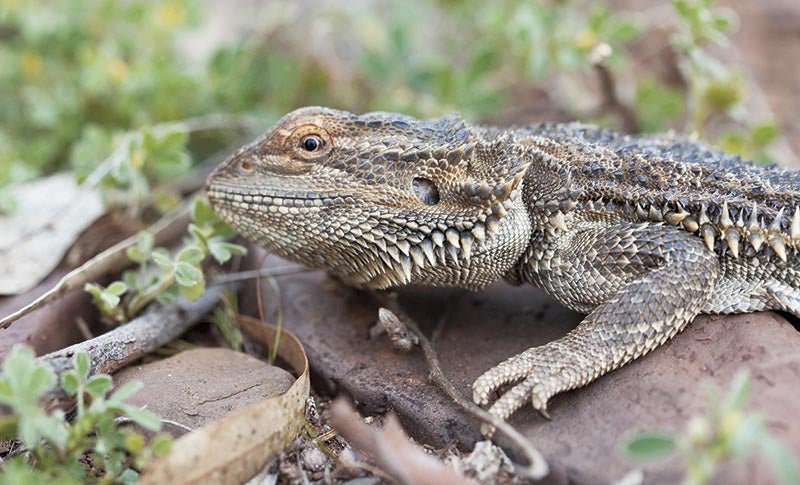
Destination: Arkaroola South Australia
|
|
Time to read 3 min
|
|
Time to read 3 min
The jagged, rocky ranges of Arkaroola Wilderness Sanctuary in South Australia’s northern Flinders Ranges rise abruptly from the flat nothingness of the outback plains that stretch as far as the eye can see. Originally higher than the Himalayas, but ground down by the elements over eons, this landscape has some of the oldest rocks on the planet. It contains a diverse range of mineral wealth, from rubies and opal to uranium.
In the mid-19th century, its mineral riches brought copper miners to the area but this arid and largely inaccessible land is not one to give up its treasures easily. Despite the hardiness and tenacity of the early prospectors, the lack of water, harsh summers, and the tyranny of distance from a port or railhead ensured their endeavours were short-lived, though various mines were worked sporadically until the 1930s.
The ruins of Bolla Bollana copper smelter, 7km west of Arkaroola village, include an amazingly well-preserved round kiln dating from the 1870s. Establishing the smelter required 70,000 firebricks and 5000 tons of wood, and while a small amount of copper was smelted, the venture was dogged by delays and collapsed before it really started.
Near Bolla Bollana are the Pinnacles, remnant plugs of granite that intruded into sedimentary rock as a result of volcanic activity 450 million years ago. Also close by are Bolla Bollana waterhole and the tongue-twisting Nooldoonooldoona Waterhole. While water levels fluctuate, both these shady spots are a great place to take a break and absorb the natural beauty around you.
Travelling west from Bolla Bollana, a rough 4WD track snakes through picturesque rolling hills to Wheal Turner and Yudnamutana. Both are sites of mining activity in the late 1800s and early 1900s. It’s an interesting area to explore but keep an eye out for unfenced mineshafts. The foundations of an old ore crushing battery at Wheal Turner have a telling inscription, “built under adverse conditions”, something of an understatement considering this was in the days of horse-drawn transport, hundreds of kilometres from civilisation.
There is an ongoing struggle to keep weeds and feral animals from invading Arkaroola. Marg recounts the story of how she found a seedpod of a datura plant by chance on one of the sanctuary’s tracks. This South American hallucinogenic plant from the nightshade family is invasive, and she believes the pod had probably fallen off a visitor’s vehicle. Marg felt that finding the seedpod before it had a chance to germinate was so fortuitous she had the pod made into an impressive gold talisman.
Arkaroola is a place with something for everyone. Check out the night sky’s attractions through one of Arkaroola’s 14in telescopes or take the famous Ridgetop tour on 4WD roads not open to the public. The tour ends at Sillers Lookout with vehicles perched precariously atop a rock outcrop overlooking an almost vertical drop into the East Painter Gorge. Here, guests enjoy afternoon tea and lamingtons while taking in the view over the ranges and plains towards Lake Frome.
A must-do is a visit to Arkaroola Waterhole around dawn or dusk to see the yellow-footed wallabies. While these beautiful creatures were almost hunted into extinction for their fur in the late 19th century, they have made a comeback under Arkaroola’s protection.
For competent 4WDers, there is the gated Echo Camp Back Track, which winds through country that becomes a kaleidoscope of colour after good rain. This one-way track exits onto a public road to Paralana Hot Springs, Australia’s last vestige of volcanic activity. The water feeding the spring becomes radioactive after percolating up through rocks rich in uranium.
There used to be a campground here 40 years ago but the springs give off radon and xenon gas and camping is no longer permitted. Back then, visitors regularly took a dip in the hot water — in the case of yours truly, without apparent ill effects.
If you’ve got a 4WD, take a day drive to Vulkathunha-Gammon Ranges National Park, 23km south of Arkaroola, where a one-way loop road takes you around this natural pound. The park’s landscapes appear lusher and less harsh than Arkaroola, despite it being literally next door. While the track is generally in fair condition, dry creek crossings require some care.
What of Arkaroola’s future? In 2012, after many years of lobbying, the Arkaroola Protection Act was passed, finally guaranteeing the protection of the sanctuary for all time. Fortunately, it now seems Arkaroola will remain a place where it is possible to spend days if not weeks exploring its natural wonders. And, having visited once, I guarantee it’s a place you’ll want to return to again and again.